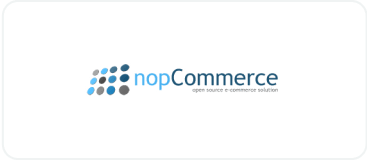Drive sales on autopilot with ecommerce-focused features
See FeaturesYour year-in-review newsletter is an opportunity to remind customers they matter beyond their credit card, reactivate the ones who forgot you exist, and prove your brand pays attention.
End-of-year emails can recap, sell, or both, but in any case, you need to avoid that mass campaign feel and create unique emails per segment with personalized content per customer using an email marketing tool, such as Omnisend.
Omnisend pulls customer data into templates and lets you intuitively build a one-time or scheduled campaign or series to match your optimal cadence.
This article provides the inspiration you need with eight real-world year-in-review examples, ideas, and best practices to follow.
Quick sign up | No credit card required
What is a year-in-review newsletter?
A year-in-review newsletter is an email campaign celebrating what you and your customers accomplished together and the moments that mattered. It can be a scheduled or one-time send, or an email series that arrives over December.
Why send a year-in-review email?
People stick with brands that chronicle their wins, and genuine recognition of customer milestones builds relationships better than any flash sale or promo code you could send.
Year-in-review emails help you:
- Reawaken dormant customers with personal victories
- Convert prospects using community proof
- Strengthen loyalty via recognition
- Spark organic sharing from memorable highlights
- Set expectations for next year’s possibilities
You already have the data, stories, and customer wins sitting in your analytics waiting to become a personalized email that people appreciate.
Forget the year-in-review, and your customers will chase brands that made them the hero of the story instead of just another email address.
Year-in-review newsletter ideas
Customers don’t need another inbox clogger about your company’s journey. They want proof they matter, evidence of progress, and content worth saving for later.
Steal these end-of-year newsletter ideas:
- Milestones and wins: Map when customers broke their own records, from first purchase to power user status. Include dates, numbers, and comparisons that make their progress undeniable, especially achievements they didn’t realize they’d hit.
- Customer impact: Calculate how customer actions shaped your business decisions, naming feedback that killed features or sparked new ones. Show the ripple effect of their suggestions with numbers on how many other users benefited.
- Popular moments: Reveal which products, posts, or campaigns customers obsessed over, including the weird ones nobody predicted. Share behind-the-scenes metrics of what flopped versus what had people coming back daily.
- Next year preview: Give customers early intelligence on what’s launching and what’s changing. Include dates and ask for their feedback. Use that information to start building your New Year email series.
- Personal message: Write something real from leadership that acknowledges what went wrong this year, alongside what worked. Skip the corporate speak and admit the struggles, surprises, and lessons customers already noticed anyway.
8 best year-in-review newsletter examples
The best year-in-review examples are on-brand and personalized when appropriate. Check out these end-of-year newsletter examples to inspire your own:
Rebel Rabbit: A fun year-in-review email
Subject line: 🐇 Rebel Rabbit Wrapped 2024
Rebel Rabbit turns its year-in-review into a visual party that celebrates both company wins and customer participation. The “2024 Review” showcases numbers (400,000+ cans sold, 700+ retail partners) alongside customer-driven data like top states where drinks landed:
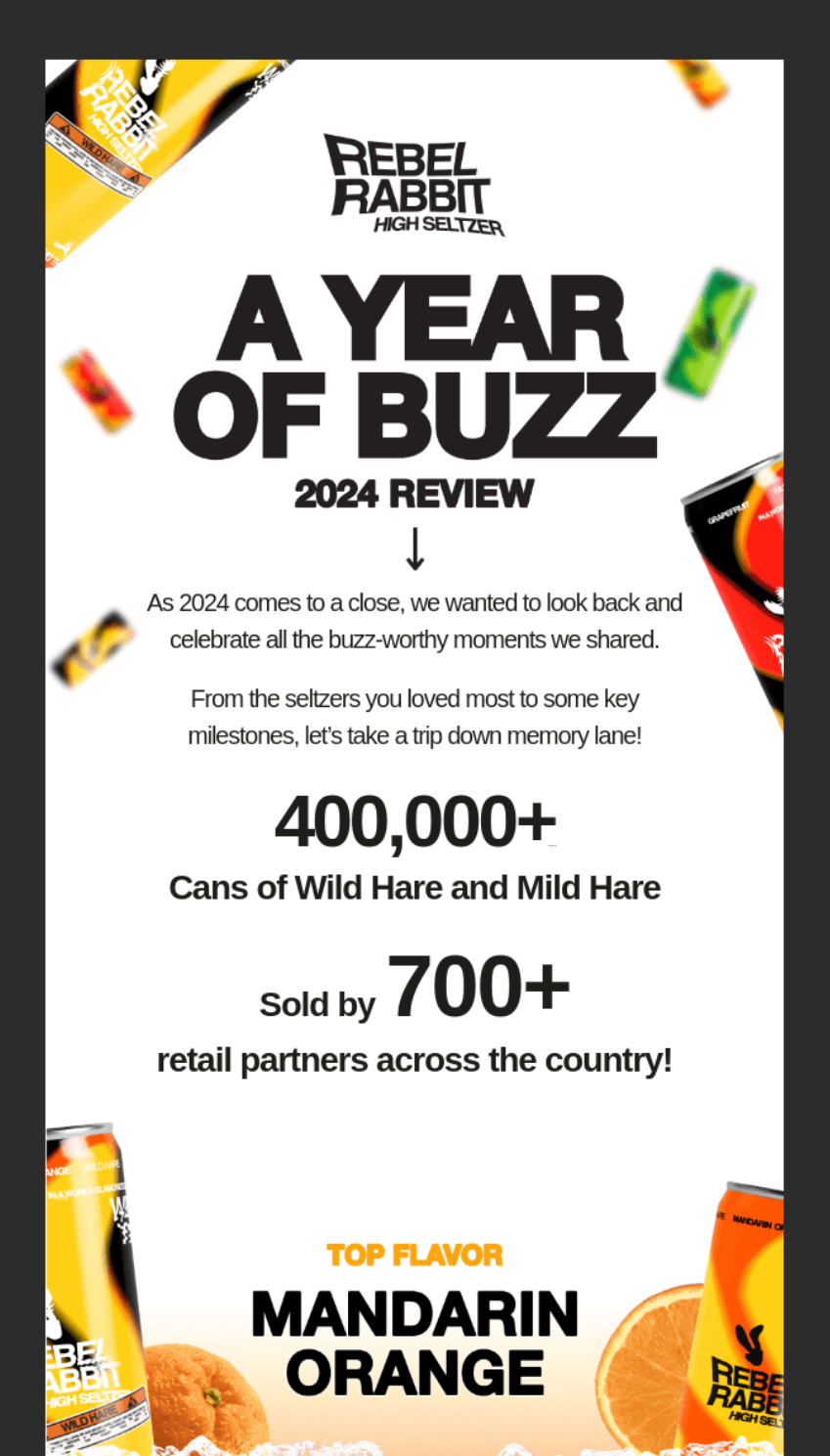
The design uses graphics and the brand’s rebellious tone instead of corporate templates, with sections like “Wilder Hare” product launch getting the same visual treatment as customer metrics. Category buttons at the bottom turn nostalgia into shopping opportunities.
What you can learn from it
- Mix company milestones with customer impact data to show how purchases shaped your year
- Use your brand’s voice and design style rather than switching to generic year-end templates
- Add shoppable elements so reflection turns into revenue
Timbuk2: Rewinding a year of bestsellers
Subject line: ICYMI: We did a LOT in 2024
Timbuk2’s year-in-review newsletter rewinds its product launches instead of using customer data and personalization, showing 2024’s bestsellers with lifestyle shots that remind people of what they might have missed:
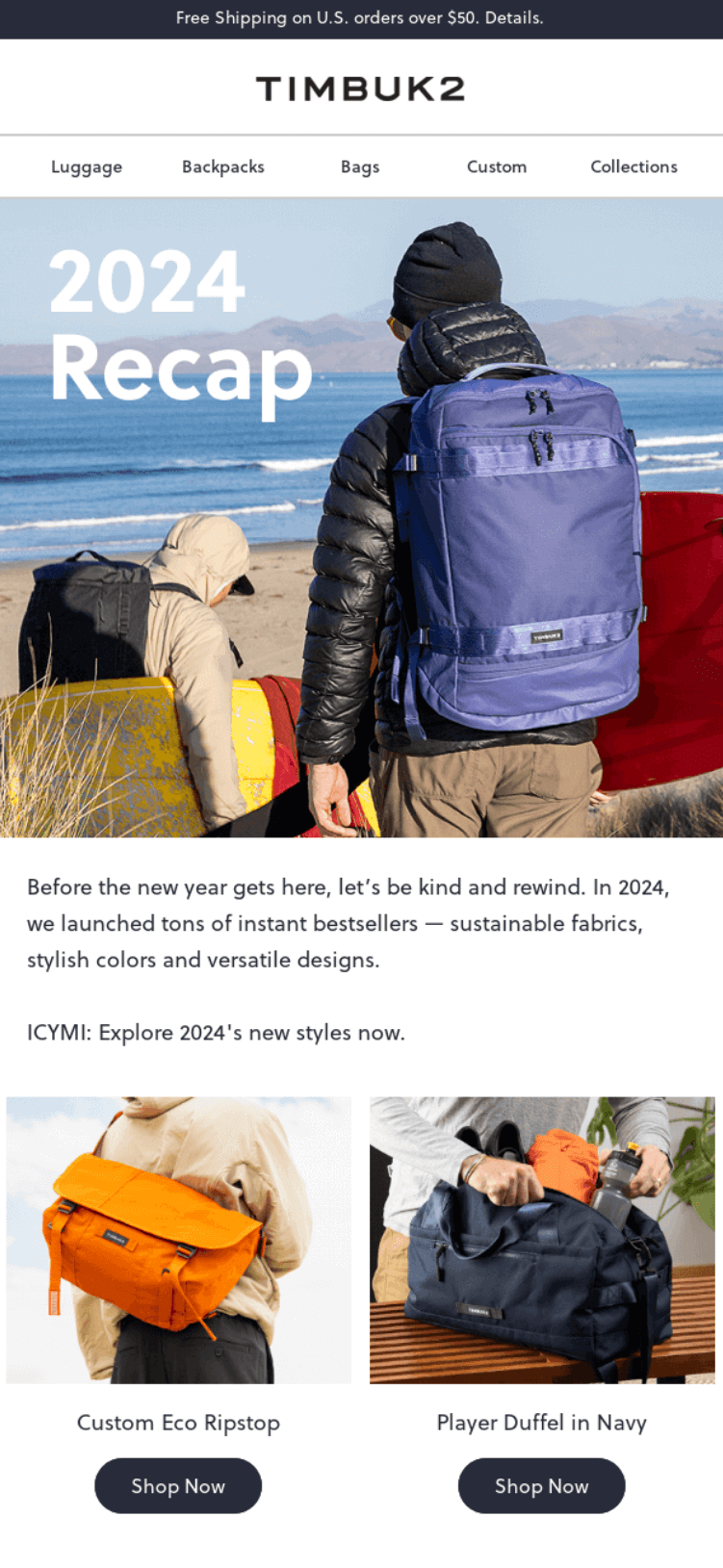
The subject line “ICYMI: We did a LOT in 2024” speaks directly to customers who zoned out during the year, giving them a second chance at products they scrolled past in July.
What you can learn from it
- Focus on product highlights when that’s what your customers care about most
- Use “ICYMI” framing to re-engage customers who missed launches throughout the year
- Keep copy minimal and let product photography carry the emotional weight
Methodical Coffee: Celebrating customer favorites
Subject line: ☕️ Your 2024 Wrapped with Methodical
Methodical Coffee leads with “from the first sips of January to the last pours of December,” turning the year into a coffee journey rather than a sales report:
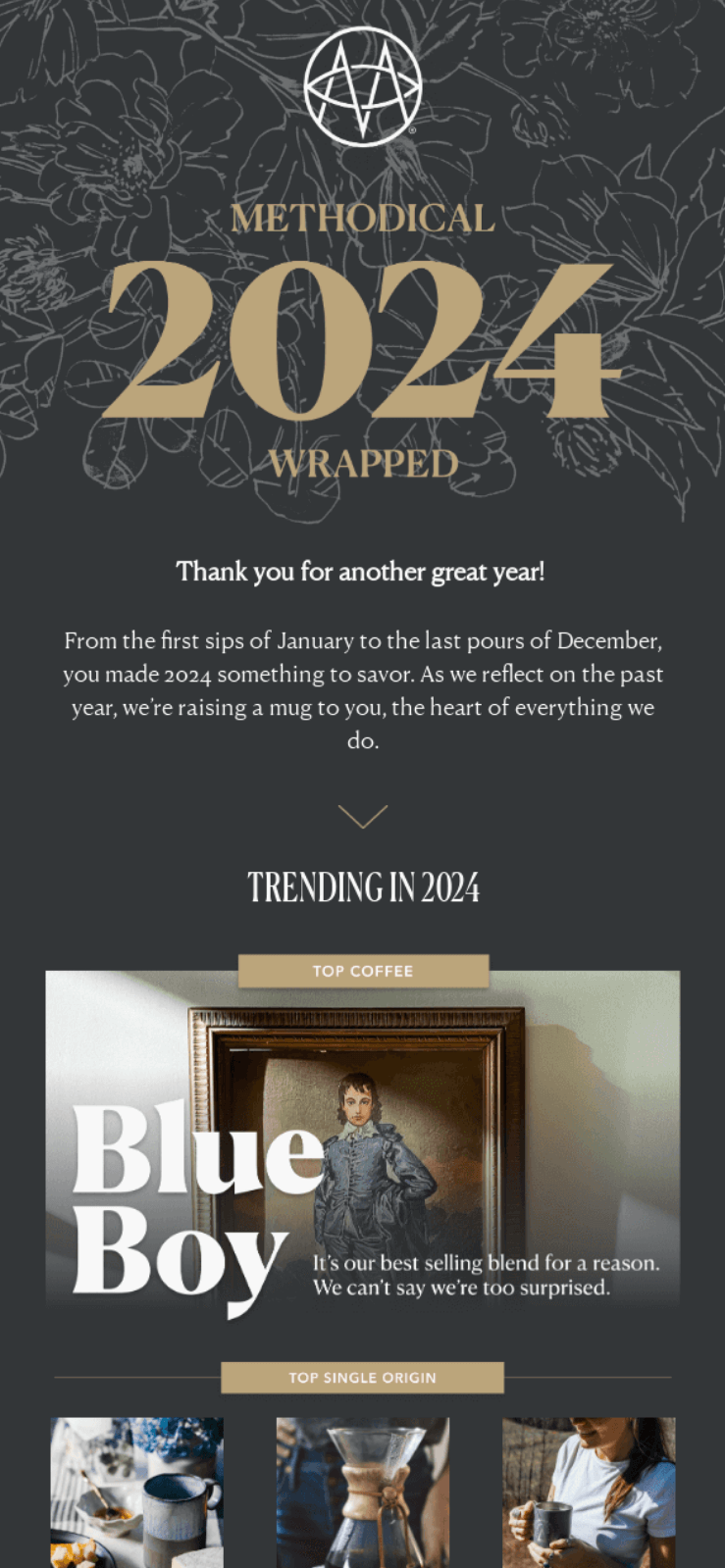
The email showcases what customers actually ordered, with its Blue Boy blend at the top, followed by single origins that kept selling out.
“We can’t say we’re too surprised,” acknowledges the winner without overselling it, while gold labels on dark backgrounds make the rankings feel curated rather than calculated.
What you can learn from it
- Write in your product’s language (sips, pours) rather than generic business terms
- Show bestsellers without manufacturing excitement about them
- Use premium design when your audience pays premium prices
New to coffee ecommerce? Read this next:
How to launch a successful Shopify coffee store
Shift Robotics: A “Thank You” year-in-review newsletter
Subject line: Thank You for an Incredible Year ✨
Shift Robotics keeps its year-in-review short, leading with “sold out twice this year” to prove demand without begging for praise:

The visual of its Moonwalkers against repeating “2024” text transitioning to “2025” carries the message without explanation. “We’ve made movement smoother” works because the company sells devices that make walking smoother.
What you can learn from it
- Lead with concrete achievements (sold out twice) rather than vague appreciation
- Use your product as a visual metaphor instead of explaining everything in text
- Keep thank-you messages brief when customers already know what they contributed
Master the art of thank you emails:
Thank you email: Examples, templates, and best practices
Uncommon Goods: Turning shopping data into storytelling
Subject line: Thank You for an Incredible Year ✨
Uncommon Goods turns purchase data into shareable moments, showing customers what they bought (a literary clock) and when they made “700k people cry at work” with a personalized gift:

Its year-in-review newsletter mixes customer data with collective achievements. “It’s pretty personalized” delivers on its promise, while sections like “Birth month gifts” and “Uncommon Experiences” remind customers of categories they haven’t explored yet.
What you can learn from it
- Turn purchase history into specific stories rather than generic order counts
- Mix personal data with community stats to make customers feel part of something
- Use every section to showcase different product categories for cross-selling
Travelodge: Personalizing the year-in-review email for each customer
Subject line: Smiles Davis, take a peek at your 2024 highlights! 👀
Travelodge personalizes every data point, showing you visited 26 times and stayed 30 nights, with Birmingham called out as “your most visited place” alongside local landmark photography:

The “Book for 2025” button appears twice before any nostalgia kicks in to encourage additional bookings. “You travelled over 3212 miles…chasing adventure this year!” gives customers a number to brag about.
What you can learn from it
- Put your call-to-action before and after the nostalgic content
- Show hyperspecific personal data (26 visits, 3212 miles) instead of rounded estimates
- Include local landmarks when you know where customers spent their time
Learn all about email personalization:
Email personalization: Strategies, tips, and best practices
Quince: Turning a recap into a shoppable showcase
Subject line: Our top launches of 2024
Quince makes its year-in-review shoppable at every scroll, with “2024 Year in Review” sitting above product grids that link directly to cashmere, denim, and bedding collections:
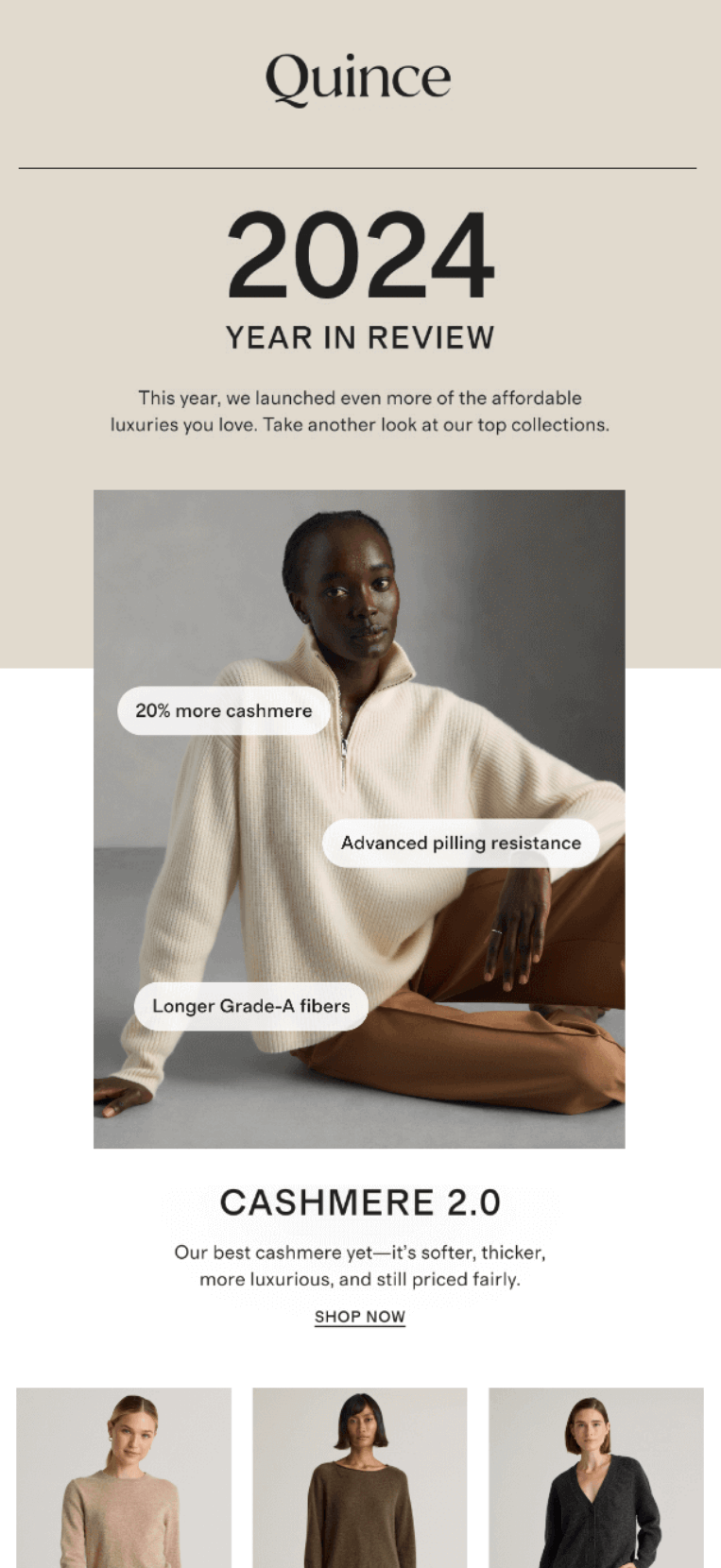
Rather than showing product recommendations based on customer purchase data, Quince showcases what sold best across categories, letting shoppers see themselves in the “Physical Denim Collection” or “Luxe Lab-Grown Diamonds.”
What you can learn from it
- Make every section of your recap directly shoppable with visible prices
- Skip personalization if your strength is product curation rather than customer data
- Let bestsellers tell the year’s story when individual metrics aren’t compelling
Looking for more fashion ecommerce tips?
7 fashion ecommerce trends to follow in 2025
Madewell: Celebrating community and style moments
Subject line: 2024, you’ve been good to us
Madewell flips the year-in-review format with brand moments rather than customer data, opening with “2024, YOU’VE BEEN GOOD TO US” to acknowledge customers without listing their purchases:

The newsletter reads like a fashion magazine retrospective with numbered sections (“01 OF COURSE ALEXA CHUNG STILL HAS ‘IT'”) and event photography from store openings and dinner parties.
Instead of showing what customers bought, Madewell shows where the brand went and who showed up, making customers feel like insiders to fashion week rather than transaction histories.
What you can learn from it
- Celebrate brand moments when individual customer data isn’t your strength
- Use editorial formatting (numbered sections, magazine layouts) for readability
- Include event photography to make customers wish they’d been there
Best practices for year-in-review emails
The mechanics of your year-in-review determine whether customers save, share, and screenshot your email or scroll past it. These tactics turn good content into memorable campaigns:
- Subject lines: Skip “Year in Review” for something customers can’t ignore, like their personal achievement or biggest purchase. Test subject lines with customer names, data points, or questions they’ll want answered about their own performance, and use Omnisend’s subject line generator for fresh ideas.
- Email design: Build for skimming with bold numbers that tell the story before anyone reads a word. Use progress bars, charts, or visual comparisons that make customers pause mid-scroll to study their own data rather than racing to delete.
- Personalization: Segment by customer behavior and show power users different metrics than newcomers. Include comparisons to similar customers, progress since they joined, and predictions for next year based on their current trajectory.
- Cadence: Send your review when customers have time to read, not during holiday chaos or inbox-clearing January. Consider breaking large recaps into digestible weekly retrospectives throughout December, building anticipation for the final summary.
- Follow-up series: Continue the conversation past January with personalized insights based on what customers clicked or ignored. Send exclusive offers for their most-used features, quarterly progress updates, or invitations to influence your product roadmap throughout the year.
Create your year-in-review newsletter with Omnisend
Omnisend gives you the email tools to build year-in-review newsletters where every customer sees their personal data without manual work.
Drag-and-drop email builder
Drop images, text, discount codes, and product blocks wherever you want them. Your logo, colors, and fonts appear automatically if you add your brand assets.
Template library
Pick from 250+ pre-built templates, each editable for retrospectives and annual recaps. Edit once, save your version, and reuse it when you need another campaign:

Automated personalization
Pull purchase history and achievements directly from your store data so customers see their milestones. Liquid templating with tags, such as [[contact.first_name]] and [[order.total_price]], fills in personal data the moment you hit send.
Scheduling
Schedule campaigns weeks ahead or send immediately. Choose whether everyone gets it at once or enable time zone optimization so Sydney customers get it at their 9 AM time, not yours.
Analytics
View numbers on opens, clicks, and unsubscribes broken down by customer segment. VIP customers might show a 68% open rate while dormant buyers hit 12%. You need to know this so you can optimize your sending pattern for next year.
Automated follow-ups
Build follow-up flows with triggers for customers who click achievements in your recap. Send them targeted offers based on what caught their attention, whether they clicked on their total savings, their VIP status, or their purchase history.
Make your year-in-review newsletter one to remember
Year-in-review newsletters let you share forgotten customer experiences and build unique narratives around your brand that no one else can match. For instance:
- A customer who sees they saved $847 this year remembers why they chose you
- Someone who discovers they were in your top 5% of buyers feels like a VIP
Send these before December 15th, when inboxes still have space. Track which recaps do best and use that data to shape next year’s personalization.
Additionally, you can create follow-up sequences that target your most engaged year-in-review readers with sales-generating offers.
The data and templates exist. Omnisend connects them, so another year of customer behavior doesn’t disappear into your archive without creating something memorable.
Quick sign up | No credit card required
TABLE OF CONTENTS
TABLE OF CONTENTS


No fluff, no spam, no corporate filler. Just a friendly letter, twice a month.
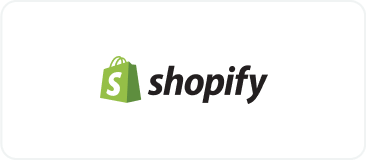
 OFFER
OFFER






